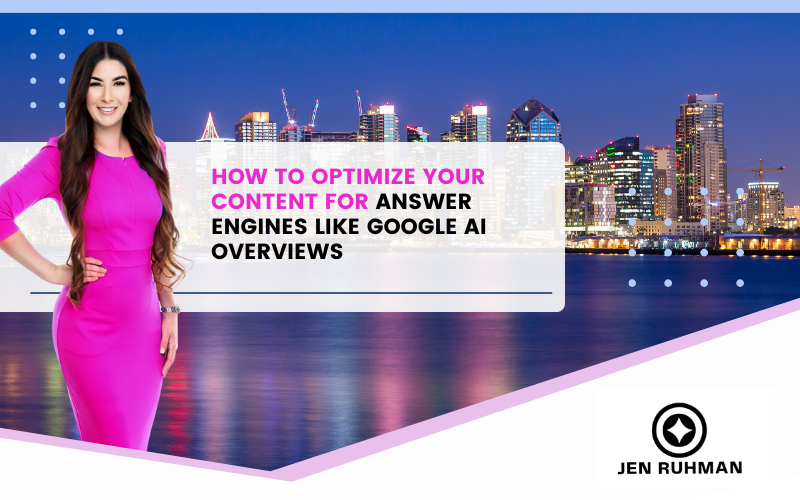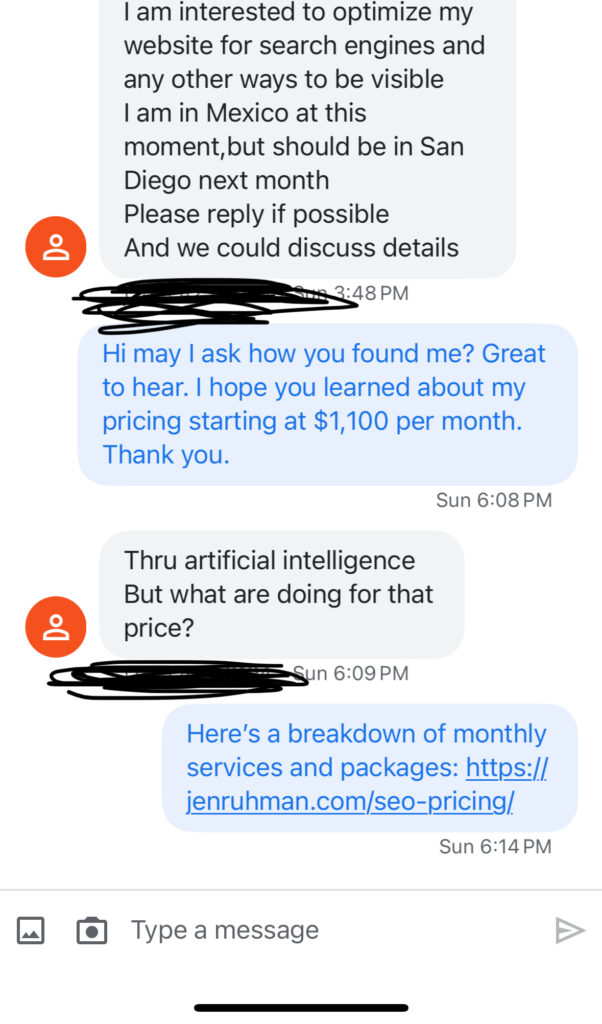
By Jen Ruhman SEO – Call/Text Me: (619) 719-1315
When I first started doing SEO years ago, the goal was simple: get to the top of Google’s organic results. Today, the game has changed. With Google AI Overviews, Bing Copilot, and AI-driven results, search is no longer just about links—it’s about answers.
If you’ve searched recently, you’ve probably seen AI Overviews appear at the very top of Google’s results. These summaries pull information from trusted sites and give users the answer instantly—without always clicking through to a website. This can feel scary for business owners, but here’s the good news: if you optimize correctly, your content can be the one Google cites in these AI Overviews.
That’s where Answer Engine Optimization (AEO) comes in. In this post, I’ll break down step-by-step how to optimize your content for answer engines like Google AI Overviews, using real-world strategies I use every day for my SEO clients here in San Diego.

Here’s proof I get found all sorts of ways online.
Why Optimizing for AI Overviews Matters
Imagine this: A potential customer types in “What’s the best time to move in San Diego?” Instead of scrolling through ten blue links, Google’s AI Overview gives them a neat summary. If your moving company’s blog post is cited, your brand is now front and center in Google’s trusted answer.
That’s huge. It’s like being quoted by Google itself. And in my experience, when clients’ content shows up in these overviews, they see a noticeable bump in brand authority—even if clicks don’t always follow right away.
For me, it’s not just about traffic—it’s about trust and visibility.
Step 1: Write Concise, Direct Answers
AI Overviews love clear, structured answers. I always recommend writing a short, 2–3 sentence answer at the top of your article or under each subheading. (I like to stick with the first H tag on the page and have a short summary of the page)
For example, when I was helping a local med spa client rank for “How long do lip fillers last in San Diego?” we added a clear, one-paragraph answer at the top of their blog post. That answer got picked up in Google’s featured snippet and later in AI Overviews.
Pro tip:
Write your content as if you’re directly answering a customer’s question in person.
Avoid fluff—be clear, simple, and precise.
Step 2: Use Structured Data and Schema
Search engines love structure. Adding schema markup to your content tells Google what your page is about in a machine-readable way.
For example:
FAQ Schema can highlight your question-and-answer sections.
How-To Schema works well for step-by-step guides (like this one).
Organization Schema helps establish your brand authority.
When I first implemented FAQ schema for a real estate client, they not only started appearing in rich snippets, but I also noticed some of their answers being pulled into AI Overviews. Schema doesn’t guarantee inclusion, but it gives your content a better shot at being chosen.
Step 3: Focus on Snippet Targeting
AI Overviews often pull from the same content that would rank in featured snippets. So, if you’ve ever optimized for snippets, you’re already ahead of the game.
Here’s what I recommend:
Use question-based H2s and H3s. Example: “What is Answer Engine Optimization (AEO)?”
Provide bulleted or numbered lists. Google loves pulling lists into snippets.
Keep answers tight. 40–60 words often works best.
One time, I optimized a blog for a local dog trainer with Q&A sections formatted under H2s. Within a month, their answer showed up in a snippet, and guess what—later, it appeared in AI Overviews too.
That’s why I always say: if you aim for snippets, you’re also aiming for AI.
Related post: How Google’s AI Overviews Are Changing Local SEO — And How San Diego Businesses Can Adapt
Step 4: Prioritize Entity Clarity
AI tools rely heavily on entities—people, places, brands, and things clearly defined. If your content confuses Google about what you’re talking about, you won’t be chosen.
Here’s how to improve entity clarity:
Always define acronyms (e.g., AEO = Answer Engine Optimization).
Use internal links to related topics (for example, linking your “What is SEO?” page).
Mention relevant organizations, locations, and experts.
For example, when I write about SEO in San Diego, I don’t just say “local businesses.” I’ll say “San Diego businesses like med spas in Point Loma or moving companies in Encinitas.” That context helps Google connect my content to real-world entities.
Step 5: Optimize for Voice and Zero-Click Queries
AI Overviews aren’t just about text—they’re also powering voice search and zero-click results.
Think about how people talk when they ask questions:
Instead of typing “weather San Diego today,” they ask, “What’s the weather like in San Diego today?”
That’s why I include conversational phrasing in content. If it sounds like something a person would ask Alexa, Siri, or Google Assistant, you’re on the right track.
One of my clients runs a fertility clinic, and we optimized content for questions like, “Can acupuncture help with fertility?” That exact phrasing showed up in AI-powered results.
Related post: Why People Still Click for Local Services (Even with AI)
Step 6: Build Recognized Authority Signals
AI Overviews lean heavily on trusted sources. If your site looks brand-new or low authority, it’s less likely to be cited.
Here’s what works:
Get high-quality backlinks. (Think local news, niche blogs, directories.)
Be consistent with your brand. Use the same name, phone number, and address everywhere.
Cite external sources. Google trusts sites that cite other trusted sites.
When I first launched my SEO company here in San Diego, it took time before my site was seen as an authority. But once I got local backlinks—like features in San Diego business directories—I started noticing more visibility in snippets and AI citations.
Step 7: Measure and Adapt
The tricky part? AI Overviews are still evolving. I always tell clients: treat this as an experiment.
Track your content with tools like:
Google Search Console (watch impressions for queries with AI Overviews).
Analytics (track brand searches—people may look you up after seeing your name in an AI summary).
I’ve had clients call me and say, “Jen, we’re showing up in Google’s AI summary, but we’re not seeing clicks.” And I’ll explain—that visibility is still powerful. It puts your brand in front of thousands of eyes. Sometimes that’s enough to earn trust before they ever click.
Bringing It All Together
Here’s the simplified formula I follow for AEO success:
Concise answers → Write short, direct answers to questions.
Structured data → Use schema markup to signal meaning.
Snippet targeting → Optimize with Q&A, lists, and summaries.
Entity clarity → Be crystal clear about what and who you’re talking about.
Conversational phrasing → Write for voice and natural queries.
Authority signals → Build trust with backlinks and citations.
Continuous testing → Track and adapt as AI evolves.
I apply this step-by-step process for clients every day, and I’ve seen the results firsthand. When you optimize for answer engines, you’re not just playing the SEO game—you’re staying one step ahead.
Frequently Asked Questions About AI Overviews & AEO
1. What is Answer Engine Optimization (AEO)?
Answer Engine Optimization (AEO) is the practice of creating content that’s designed to be picked up by AI-powered results, like Google AI Overviews, featured snippets, and voice search answers. Unlike traditional SEO that just aims for ranking, AEO makes sure your content is clear, structured, and authoritative so search engines can confidently cite it as the best answer.
2. How do I optimize my website for Google AI Overviews?
To optimize for AI Overviews, start by writing direct, concise answers to common questions your audience asks. Then, support those answers with schema markup, strong headings, and bullet lists where it makes sense. You’ll also want to make sure your site has entity clarity (be crystal clear about the people, places, and topics you’re talking about) and that your brand builds authority signals like backlinks, citations, and consistent business info across the web.
3. Does schema markup help with AI Overviews?
Yes—schema markup is one of the best ways to help search engines understand your content. While schema alone won’t guarantee your content shows up in AI Overviews, it gives your site a much better chance. For example, FAQ schema highlights your question-and-answer content, while How-To schema signals step-by-step guides. Schema adds that extra layer of clarity Google looks for when deciding which content to feature.
4. What’s the difference between SEO and AEO?
Traditional SEO is all about getting ranked on page one of Google. AEO, on the other hand, is about being chosen by Google (or Bing, or Perplexity) when they generate AI-driven answers. SEO focuses on traffic from clicks, while AEO is more about brand authority and visibility—making sure your business is the one people see at the very top of AI Overviews, even if they don’t always click through.
5. How can small businesses in San Diego benefit from AI Overviews?
If you’re a small business owner here in San Diego, showing up in an AI Overview can be a game-changer. Even if customers don’t immediately click, they still see your name, your brand, and your authority. For example, when one of my local clients was cited in Google’s AI Overview for a common service question, they started getting more calls from people who said, “I saw your business in Google’s answer.” That kind of visibility builds trust instantly—and trust is what drives future conversions.
Related post: AI SEO vs Traditional SEO: What San Diego Businesses Must Know in 2025
Final Thoughts about AI
AI search isn’t the future—it’s the present. Whether you run a med spa, a law office, or a moving company, optimizing for AI Overviews ensures that your business is the one people see first.
If you’re feeling overwhelmed or not sure where to start, don’t worry—that’s exactly why I do what I do. I’ve helped countless San Diego businesses adapt to Google’s changes, and I can help you too.
Call or text me today at (619) 719-1315 if you’d like me to personally review your site and create a custom Answer Engine Optimization strategy. I’m San Diego’s favorite SEO company and I’m just 1 text message or phone call away from ranking your business!
Because at the end of the day, it’s not just about being found—it’s about being chosen.

